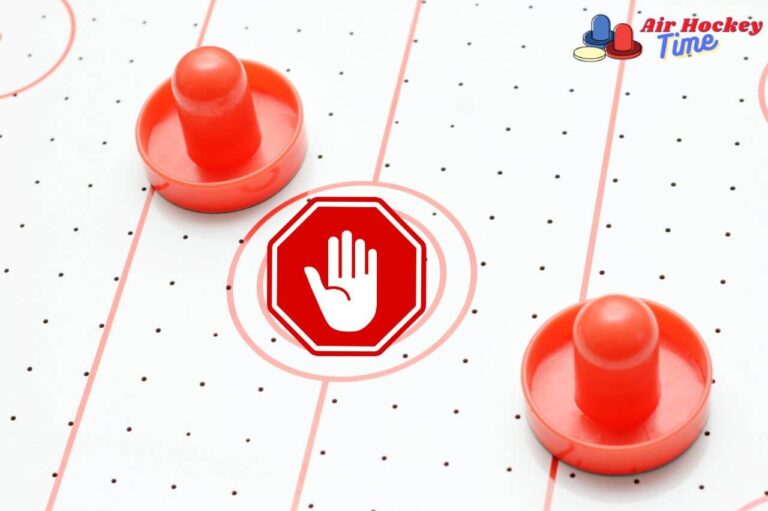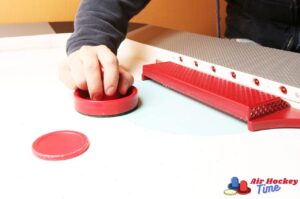Air hockey is a fast-paced and thrilling game that requires quick reflexes and strategic maneuvering.
One common question during gameplay is whether players can stop the puck with their mallets.
The interaction between the puck and the mallet is a critical aspect of the game, and understanding the rules surrounding this action is essential.
In this discussion, we will explore the rules and guidelines regarding stopping the puck with the mallet in air hockey.
By gaining clarity on this matter, players can enhance their gameplay, make informed decisions, and strive for success in the exciting world of air hockey.

What is the primary purpose of an air hockey mallet?
The air hockey mallet, a striker or paddle, is a player’s primary tool and plays a vital role in the game.
The primary purpose of an air hockey mallet is to strike the puck and propel it across the table with speed and accuracy.
Designed with a flat bottom surface and a comfortable grip, the mallet allows players to exert control and manipulate the puck’s movement.
By striking the puck with the mallet, players aim to outmaneuver their opponents, navigate through defenses, and ultimately score goals.
The mallet’s design and functionality, combined with the skill and technique of the player, contribute to the fast-paced and exhilarating nature of air hockey.
Mastering the mallet is essential for players to showcase their abilities, make precise shots, and gain a competitive edge on the air hockey table.
Can you physically stop the puck with the air hockey mallet?
In the game of air hockey, the rules specify that players are not allowed to physically stop the puck with their mallets by bringing them down on the puck or dragging it.
The mallet aims to strike the puck, redirect its trajectory, and keep the game in motion. The emphasis is on maintaining the game’s fast-paced nature and encouraging continuous action. Stopping the puck with the mallet in such a manner would impede the flow of the game and disrupt the dynamics of gameplay.
Making such a move is a violation of air hockey rules.
Instead, players must rely on their agility, timing, and strategic positioning to anticipate the puck’s movement and respond accordingly.
By adhering to these guidelines, players can engage in fair play, showcase their skills, and experience the thrilling excitement that air hockey offers.
What strategies can block the puck without bringing the mallet down on it?
In air hockey, players can employ several effective strategies to block the puck without physically topping it by bringing their mallet on top of it.
One approach is strategically positioning the mallet to create barriers and angles that make scoring challenging for the opponent.
By anticipating the puck’s movement and quickly adjusting the position of the mallet, players can effectively block the puck’s path and force their opponent into making difficult shots.
Additionally, players can utilize the edges and corners of the table to their advantage, using the rebound effect to redirect the puck away from their goal.
Quick reflexes, precise movements, and spatial awareness are essential to successfully employing these strategies.
By combining defensive tactics with offensive counterattacks, players can create a formidable defense that denies their opponents scoring opportunities and increases their chances of winning.
Tips to improve your air hockey game and best practices for avoiding penalties
Several tips and best practices can be followed to enhance your air hockey game and minimize the risk of penalties.
Firstly, focus on improving your hand-eye coordination and reflexes through regular practice.
This will help you react swiftly to the puck’s movements and make accurate shots.
Additionally, maintain proper positioning on the table by staying centered and balanced, allowing you to cover more area and effectively defend your goal.
It is crucial to avoid leaning on the table or using excessive force, as these actions may result in penalties.
Furthermore, familiarize yourself with the game’s rules, such as not crossing the centerline or topping the puck with your mallet.
You can avoid penalties and ensure fair play by understanding and adhering to these rules.
Lastly, maintain good sportsmanship, respect your opponents, and play with integrity.
These qualities create a positive gaming experience and foster a competitive yet friendly atmosphere.
By implementing these tips and best practices, you can elevate your air hockey skills, minimize penalties, and enjoy the game to the fullest.
Frequently asked questions
Can you lift in air hockey?
In the air hockey game, it is essential to note that lifting the mallet is not allowed.
This rule is in place to ensure fair play and maintain the integrity of the game.
Lifting the mallet can lead to unfair advantages, such as topping the puck or interfering with the opponent’s shots.
By disallowing mallet lifting, players are encouraged to rely on hand-eye coordination, quick reflexes, and strategic positioning to control the puck effectively.
It adds an element of skill and precision to the game, as players must focus on guiding the puck along the table’s surface without lifting their mallet.
By adhering to this rule, players can engage in a fair and competitive game of air hockey, where success is determined by technique, strategy, and accuracy.
What is the paddle called in air hockey?
In the exhilarating air hockey game, the paddle used to strike the puck is commonly called a striker.
Other names, such as a goalie, mallet, or paddle, also know this essential tool.
The striker is a crucial element in the game, serving as the player’s primary means of interacting with the puck.
It is designed to be lightweight and maneuverable, allowing players to swiftly and accurately hit the puck toward their opponent’s goal.
The striker’s smooth surface and comfortable grip enable players to showcase their agility, hand-eye coordination, and precision.
Whether referred to as a striker, goalie, mallet, or paddle, this vital instrument plays a central role in the fast-paced and exciting sport of air hockey.
In conclusion
In the exhilarating air hockey game, the rules explicitly state that players cannot physically stop the puck with their mallets by topping or dragging it.
By prohibiting the act of stopping the puck with the mallet, players are encouraged to engage in continuous movement, maintaining the flow and excitement of the game.
Adhering to this rule ensures fair play, allowing players to showcase their agility, accuracy, and ability to anticipate the puck’s trajectory.
Instead of stopping the puck with the mallet, players must rely on effective defensive techniques, timely interceptions, and precise puck redirection to challenge their opponents and protect their own goals.
By respecting this rule, players can fully embrace the spirit of air hockey and experience the thrill of fast-paced competition.








